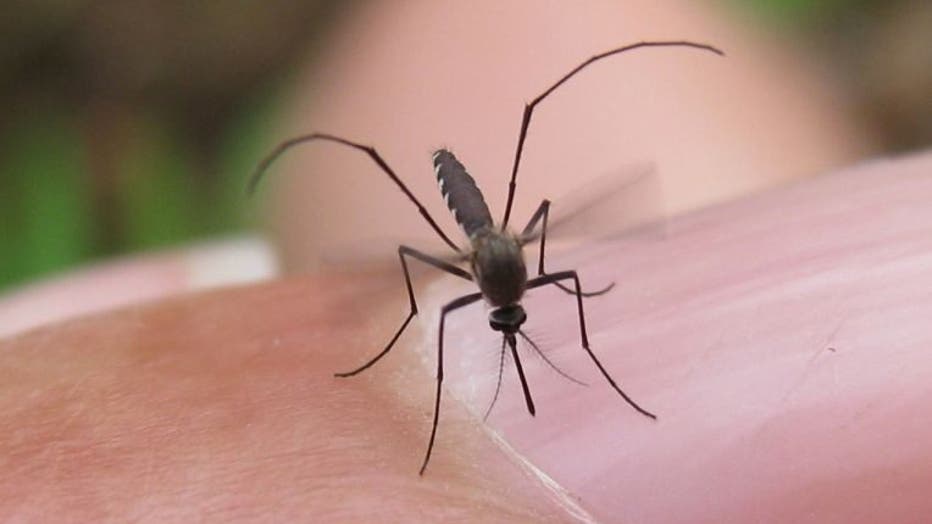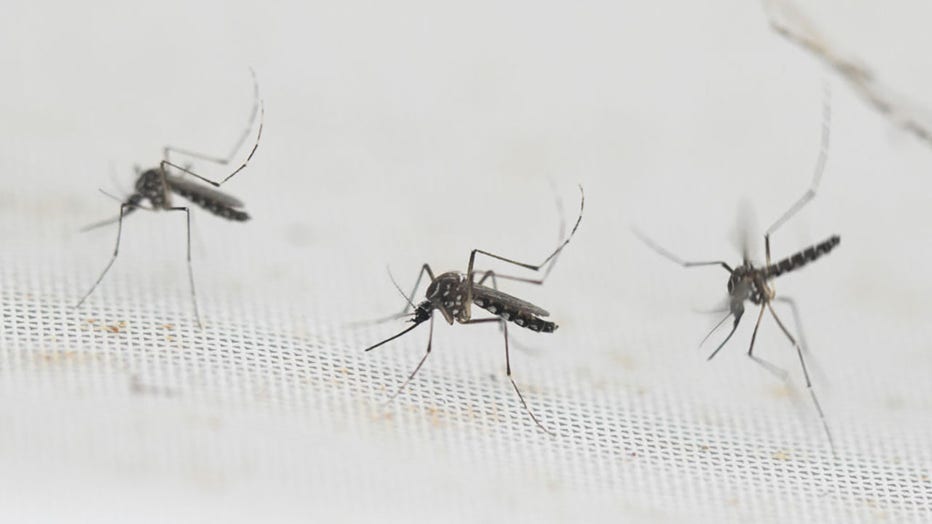How Joro spiders, lanternflies, mosquitoes, could bug NYC this summer: 2024 forecast

Joro spiders heading to New York
If you thought spotted lanternflies were bad, there's a new pest headed our way called the joro spider. They can grow as large as eight inches, but as FOX 5 NY?s Teresa Priolo explains we don?t need to be too concerned.
NEW YORK CITY - Joro spiders, spotted lanternflies and ticks. . . oh my!
JUMP TO: JORO SPIDERS l SPOTTED LANTERNFLIES l TICKS l MOSQUITOES
The summer of 2024 is expected to be a very active season for bugs in NYC.
Here's everything you need to know about the creepy crawly critters infesting our city.
Joro spider: 2024 summer forecast
Giant, flying Joro spiders, native to East Asia, are moving northward across the East Coast. The question isn't if they're coming to the NYC area -- it's when.
"If you're an arachnophobe, these things are the stuff of your nightmares," Andy Davis, an ecologist with the University of Georgia, told FOX 5 NY. "They're so big, they're so striking, and they're so scary-looking."

The Joro spider, a large spider native to East Asia, is seen in Johns Creek, Ga., on Sunday, Oct. 24, 2021. (AP Photo/Alex Sanz, File)
The large and vividly colored Joro spider, with its 4-inch-long legs enabling it to glide through the air, might reach as far north as New Jersey this summer, New Jersey Pest Control warned earlier this year.

The Joro spider, a large spider native to East Asia, is seen in Johns Creek, Ga., on Sunday, Oct. 24, 2021. (AP Photo/Alex Sanz, File)
The Joro, when full-grown, is the size of a human palm.

The web of a Joro spider.
"The origins of the Joro spider invasion trace back to the theory that they were unintentionally transported to the United States via human activities," NJ Pest Control said. "Cargo shipments, international trade, or personal travel could have facilitated their journey across the ocean."

Fully grown, the Joro spider is the size of a human palm. (Carly Mirabile/UGA)
"Their webs are absolutely enormous," Andy Davis, an ecologist at the University of Georgia, said. "They are at least three or four feet in diameter, and the other thing is they're really, really strong. If you walk into one, it'll stop you."
And they bite.
"The Joro spider can bite humans, but it prefers to avoid confrontation. The spider also has small fangs that don't easily pierce human skin. In the unlikely event that a Joro spider bites you, the bite will feel like a bee sting and may cause temporary redness," WebMD said.
Featured
What to do if a Joro spider bites you
These large, long-legged spider spiders are not considered to be aggressive, however, they are venomous.
Click here for our full report on Joro spiders.
Spotted lanternfly: 2024 summer forecast
See it? Squish it! The invasive, and annoying, spotted lanternfly is expected to return this summer to NYC.

Traps for spotted lanternflies
Native to Asia, the spotted lanternfly first appeared in New York and New Jersey a couple of years ago. The insect is considered invasive. But traps for lanternflies could also snare birds, so be careful how you set up the traps.
According to a map from the New York State Integrated Pest Management Program, all of NYC, New Jersey, Long Island and parts of Connecticut were highlighted for reported infestations.
So, what's the forecast for 2024? Will we see more or less of the insect in NYC compared to last year? Here's everything you need to know:
When do spotted lanternflies hatch?
The insects will hatch from May through June, living as adults from July through December. Egg laying takes place from September through November, according to Cornell University.
Featured
Spotted lanternflies could target Long Island vineyards
Vineyard owners on the east end of Long Island are gearing up to protect their grape harvest from a new threat: the spotted lanternfly.
"The spotted lanternfly nymphs are currently emerging from the egg masses that were laid last fall," said Brian Eshenaur, senior extension associate with NYS Integrated Pest Management at the university. "Those nymphs are small, flightless and typically feed on vegetation lower to the ground, so they are often go unnoticed. These nymphs will develop into the adult form that we’re very familiar with in July."
Will we see more or less this year in NYC?
"In parts of the city that had high populations of spotted lanternfly for the last two years, we are anticipating a slight decline and leveling off of the populations," Eshenaur said. "This population decline, which occurs after a couple of years of high populations, has occurred in other urban areas, and we expect it to play out in NYC as well. It doesn’t mean the spotted lanternfly will be gone. We’ll still see them, but the numbers may be lower this year and going forward."

See it, squish it: NJ residents urged to stomp out Spotted Lanternflies
Spotted Lanternflies may look gorgeous, but they are a nuisance that ruin the quality of life in the communities where they multiply, and officials are asking residents in New Jersey to stomp out any of the insects they see.
Meanwhile, Hanna Birkhead, with the Department of Agriculture and Markets, had this to say:
"SLF populations will show variability from season to season," Birkhead said. "In areas where SLF is established, residents will continue to observe significant numbers of SLF."
Why are numbers declining?

A spotted lanternfly stands on a post in front of the skyline of lower Manhattan in New York City on August 27, 2023, in Weehawken, New Jersey.
"We’re not sure exactly what is responsible for the decline in numbers," Eshenaur said. "Part of it may be due to stress on its favorite host plant, the Tree of Heaven also there seems to be an increase in predators such as other insects and birds that begin to feed on spotted lanternfly after a couple of years."
People also unknowingly transport spotted lanternfly eggs, which are laid later in the season. Females leave masses of 30 or more eggs on all sorts of surfaces, from tree trunks to patio furniture. Eggs laid on portable surfaces, like camping trailers and train cars, can hatch in the spring many miles away.
Click here to learn more about spotted lanternflies in NYC.
Mosquitoes: 2024 summer forecast
Mosquitoes are most active during the warmer months and thrive in damp environments.
According to NOAA, the Northeast is forecast to experience above-average temperatures and precipitation -- perfect conditions, if you're a mosquito. In fact, New York ranks No. 2 on Orkin's top 2024 Mosquito Cities List.

Despite their omnipresence, mosquitoes can pose potential threats to humans thanks to West Nile virus transmission. Most infected people do not develop symptoms, but severe illness can develop in those with weakened immune systems.
From 1999 to 2023, 444 New York City residents suffered neuroinvasive disease due to West Nile virus. Among these cases, 61 died as a result of the infection, according to the city's Department of Health and Mental Hygiene.
The city will be spraying pesticides starting Friday, June 7, throughout four of the five boroughs. Click here to find out which areas are affected.

FILE - Aedes aegypti mosquitoes are pictured at a laboratory of the Center for Parasitological and Vector Studies (CEPAVE) of the national scientific research institute CONICET, in La Plata, Buenos Aires Province, Argentina, on March 26, 2024. (Photo
Mosquito forecasting tool
OFF!, the SC Johnson bug spray brand, created an interactive tool that gives users localized seven-day mosquito forecasts. The company says it uses weather patterns, data points from mosquito traps and insect research to deliver the forecast.
Click here to find your area's mosquito forecast.
Tick: 2024 summer forecast
Ticks are most active in spring, summer and fall and can be found in cooler areas where trees, leaf litter, brush and tall grasses provide cover and shade from the sun.
Facts about ticks
The bugs avoid heat and direct sunlight, and feed on blood and will wait for a person or animal to walk by to grab onto. They will then crawl onto the person or animal and search for a suitable spot on the body to attach and feed.

Ticks on Long Island
The risk of getting a disease from a tick bite is very real. One doctor tells FOX 5 NY that he has seen some people hospitalized after contracting a tick-borne illness.
"Most NYC residents diagnosed with a tick-borne disease are infected when visiting grassy, wooded areas in upstate New York, Long Island, and surrounding states," NYC Health said. "However, several types of ticks have been found in New York City. Some of them have tested positive for the germs that cause Lyme disease and other tick-borne diseases."
What percentage of ticks carry Lyme disease?
"Ticks prefer to live in wooded areas, low-growing grasslands, and yards," according to John Hopkins Medicine. "Not all ticks carry the Lyme disease bacteria. Depending on the location, anywhere from less than 1% to more than 50% of the ticks are infected with it."
Where are lone star ticks?
"Lone star ticks live in Staten Island and can sometimes be found in the north Bronx," NYC Health said. "They are about the size of a pea and can spread ehrlichiosis. They have also been linked with alpha-gal syndrome."

Ticks in Connecticut linked to deadly virus
A warning from health officials in Connecticut after a man there was diagnosed with a potentially deadly virus linked to tick bites.
How to kill ticks in yards
Here are some tips from NYC Health:
- Create a barrier to define a tick-safe zone (PDF) around your yard.
- Keep grass short and don’t let piles of brush or leaves build up.
- Trim shrubs and tree branches around your yard to let in more sunlight.
- Keep playground equipment and outdoor furniture in a sunny location, away from yard edges and trees.
- Don’t leave out food that attracts deer and other wildlife.
- Consider hiring a pest management professional. To learn more visit the New York State Pesticide Administration Database
Here is an interactive map of U.S. counties that have reported infected ticks.
Cicada 2024: summer forecast
A cicada double brood is expected to emerge across much of the eastern part of the United States through May this year, according to the U.S. Department of Agriculture Forest Service.

Zombie-like fungus in cicadas
More than a dozen states will see swarms of cicadas in the next few weeks and some of the bugs could emerge with a fungus that controls its body and mind. While our area will be spared from cicadas this summer, experts are still keeping a close eye on this zombie-like fungus. FOX 5 NY's Teresa Priolo has the details.
It’s been over two centuries since the two broods last emerged in the same year, back in 1803. But will it happen in NYC?
Do cicada killers sting humans?
"Female cicada killer wasps have large stingers, and their sting can be very painful, but they rarely sting humans," AmericanPest.net said. "Unlike other stinging insects, these wasps don’t even have nest-protecting instincts.:
When are the cicadas coming to New York?
No periodical broods will be emerging in the NYC area in 2024, but be on the lookout for Brook IV in 2025!
Click HERE for more information.
Are there cicadas in New Jersey?
See above. Similar situation for the Garden State/
FOX Weather, as well as the Associated Press wire services, helped contribute to this report.



